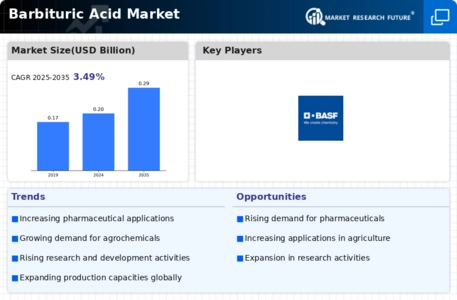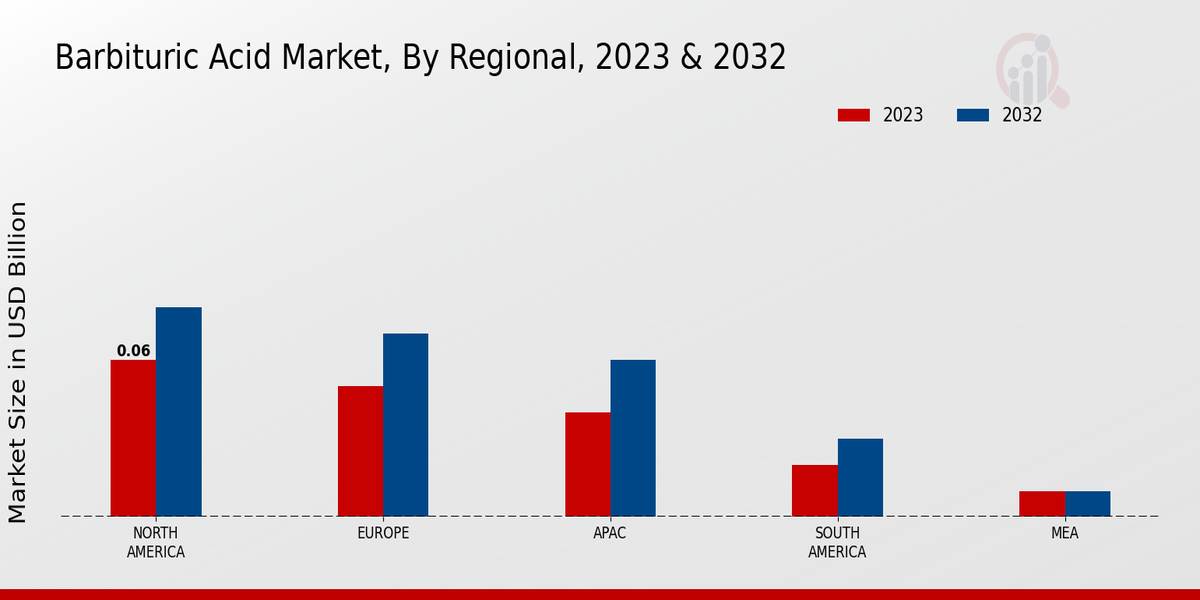Market Growth Projections
The Global Barbituric Acid Market Industry is projected to experience steady growth over the coming years. With an estimated market value of 0.2 USD Billion in 2024, the industry is expected to reach approximately 0.29 USD Billion by 2035. This growth trajectory is indicative of a compound annual growth rate (CAGR) of 3.43% from 2025 to 2035. Such projections highlight the increasing relevance of barbituric acid across multiple sectors, including pharmaceuticals and agriculture. The anticipated growth reflects not only the rising demand for barbituric acid derivatives but also the ongoing advancements in production technologies and applications.
Rising Research Activities
Research and development activities in the field of organic chemistry are contributing significantly to the Global Barbituric Acid Market Industry. Academic institutions and research organizations are increasingly focusing on the synthesis of novel compounds derived from barbituric acid, which could lead to innovative applications in various fields, including agriculture and materials science. This heightened interest in research is likely to enhance the market's growth trajectory. The anticipated compound annual growth rate (CAGR) of 3.43% from 2025 to 2035 indicates a promising outlook for the industry, as new discoveries may open up additional avenues for barbituric acid utilization.
Growing Demand in Pharmaceuticals
The Global Barbituric Acid Market Industry is experiencing a surge in demand from the pharmaceutical sector, primarily due to its applications in the synthesis of various drugs. Barbituric acid serves as a precursor for barbiturate medications, which are utilized in anesthesia and sedation. The increasing prevalence of surgical procedures and the need for effective anesthetic agents are driving this demand. As of 2024, the market is valued at approximately 0.2 USD Billion, with projections indicating growth as the healthcare sector expands. This trend suggests a robust future for the Global Barbituric Acid Market Industry, particularly as advancements in medical technology continue to evolve.
Expanding Applications in Agriculture
The Global Barbituric Acid Market Industry is witnessing an expansion in its applications within the agricultural sector. Barbituric acid derivatives are being explored for their potential use as herbicides and pesticides, offering a new avenue for crop protection. This trend is particularly relevant as the global population continues to grow, necessitating increased agricultural productivity. The integration of barbituric acid into agrochemical formulations may provide effective solutions for pest management. As the market evolves, the potential for barbituric acid in agriculture could significantly contribute to its overall growth, aligning with the projected market value of 0.29 USD Billion by 2035.
Regulatory Support and Safety Standards
Regulatory support and the establishment of safety standards are pivotal for the Global Barbituric Acid Market Industry. Governments worldwide are implementing stringent regulations to ensure the safe use of chemicals in pharmaceuticals and agriculture. This regulatory framework is fostering a safer environment for the production and application of barbituric acid. Compliance with these regulations not only enhances consumer confidence but also encourages manufacturers to invest in quality assurance processes. As the industry navigates these regulatory landscapes, the emphasis on safety and compliance is likely to bolster market growth, ensuring that barbituric acid remains a viable option in various applications.
Technological Advancements in Synthesis
Technological advancements in the synthesis of barbituric acid are playing a crucial role in shaping the Global Barbituric Acid Market Industry. Innovations in chemical processes and methodologies are enhancing the efficiency and yield of barbituric acid production. These improvements not only reduce production costs but also minimize environmental impact, aligning with global sustainability goals. As manufacturers adopt these advanced techniques, the market is likely to benefit from increased supply and reduced prices. This trend is expected to support the market's growth, particularly as the industry adapts to evolving regulatory standards and consumer preferences.



